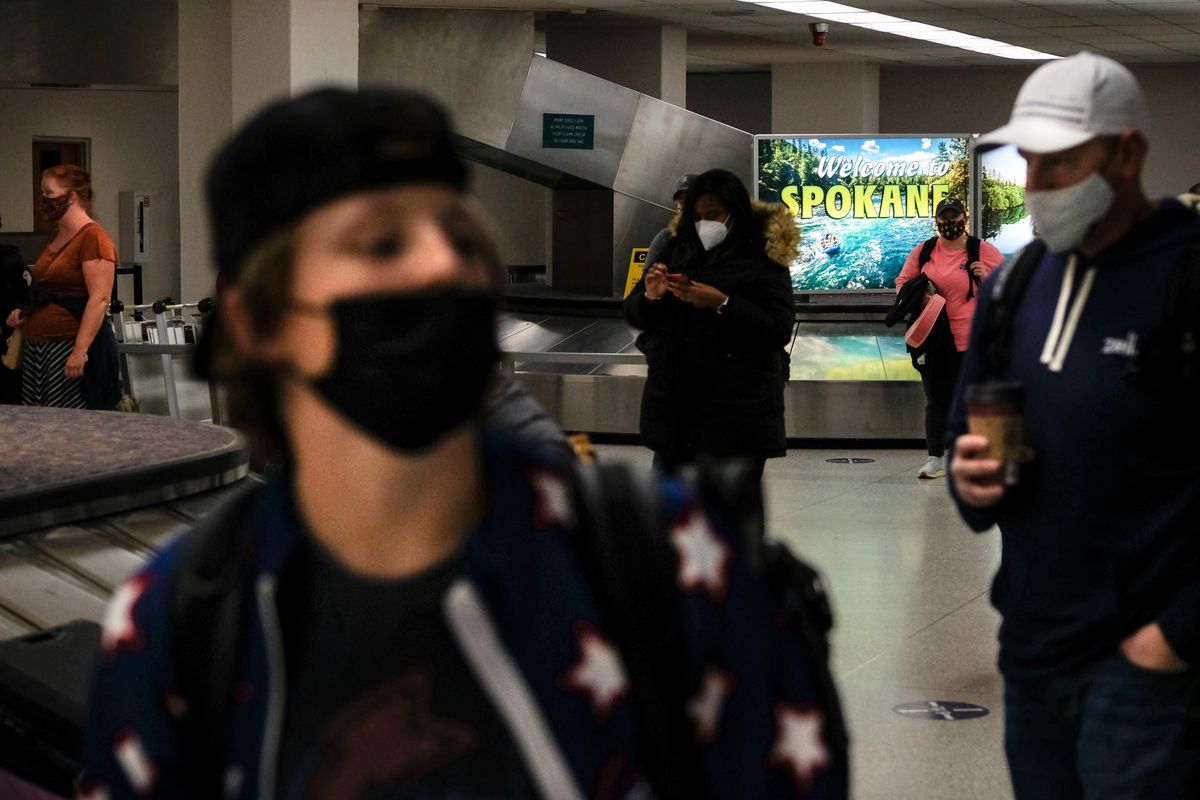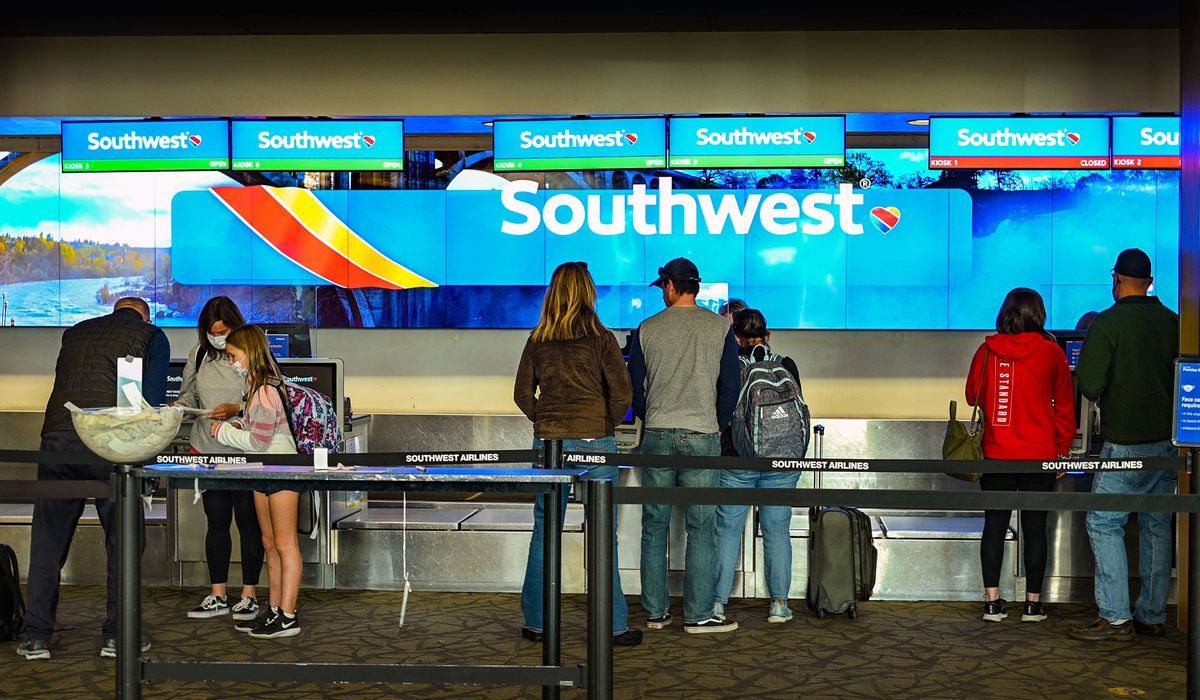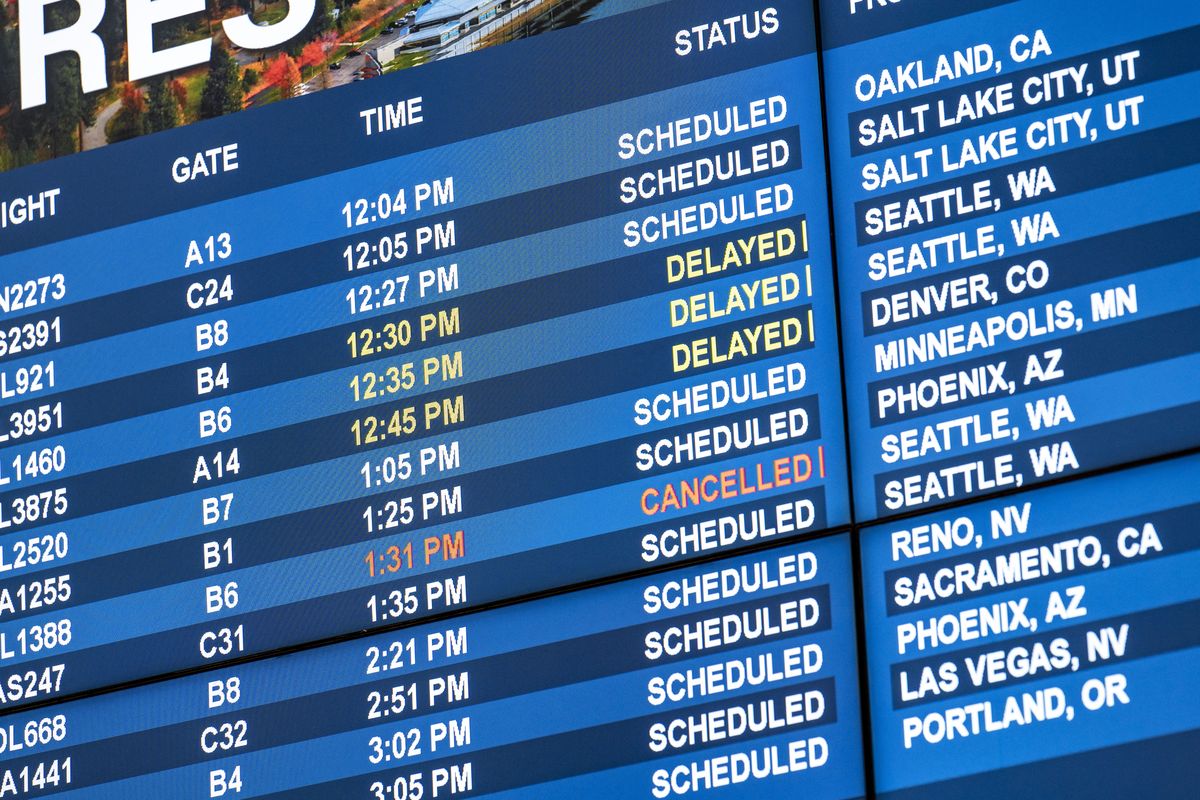Shawn Vestal: Airlines’ many challenges leaving flyers feeling ‘worse and worse’
Travelers to and from Spokane International Airport have faced holiday travel delays in the form of canceled and delayed flights, Wednesday, Dec. 29, 2021. (COLIN MULVANY/THE SPOKESMAN-REVI)
Larry Weir’s job has sent him into the air for more than 30 years.
In that time, Weir – the play-by-play radio announcer for Eastern Washington University sports – has seen the friendly skies become less friendly.
The traveler’s experience has been whittled nearly bare. Seats have shrunk. In-flight services vanished. The system is crowded and chaotic from tip to tail. Your baggage sometimes takes a different trip than you do. Delays and cancellations are increasingly common, and stranded fliers face a pared-down and often impenetrable customer-service system.
“If you’re one of the haves, you’re in pretty good shape,” Weir said last week. “If you’re one of the have-nots, it can be pretty unpleasant.”
Weir’s lament is widely shared. As the airline industry works to rebound from the pandemic – boosted by tens of billions of dollars in taxpayer subsidies – complaints have soared. The most recent Department of Transportation report on airline performance showed consumer complaints were 320% higher in the six months leading up to October than the year before the pandemic, 2019.
Since that report, the airline industry suffered two major emergencies: the widespread flight cancellations over the holidays, which were chiefly tied to Southwest Airlines’ outdated computer scheduling system, and the breakdown of the Federal Aviation Administration’s flight safety communications system in January, which led to a brief but high-profile shutdown of flights nationwide.
There are, it seems, problems everywhere you look. Airlines have significant staffing shortages at every position from maintenance technicians to air traffic controllers to flight captains. The recent crises exposed the inadequacy of technological systems that would need major upgrades. There are delays in building new planes, which limits airlines’ ability to grow to meet customer demand, which rebounded more quickly than many expected.
In the most basic terms, many observers say, the system is not big enough for the number of people using it. Industry experts don’t expect it to get any better soon.
United Airlines CEO Scott Kirby recently blasted some of his competitors as being in “denial” that the system needed deep structural changes. He and other airline executives are calling on the government to expand funding for industry infrastructure.
“The system simply can’t handle the volume today, much less the anticipated growth,” Kirby said in United’s fourth-quarter earnings call last month. “There are a number of airlines who cannot fly their schedules. The customers are paying the price.”
Delays and cancellations
On average, one in every four U.S. flights arrived late last year, and more than two out of every 100 flights were canceled, according to the Punctuality League, an annual report by the travel-data firm OAG, based in the U.K.
But punctuality and reliability in air travel depends heavily on the carrier – and the airport. Delta was the most punctual among airlines last year, according to the report, followed by Alaska and United. All had an on-time percentage of around 80% – with “on-time” defined as within 15 minutes of schedule.
A similar variation exists among airports. Spokane International is among the best in the country, ranking fourth among all North American airports with an on-time percentage of 81.29% – behind Salt Lake City, Boise and Fresno, California. Spokane’s cancellation rate is 1.52%, also below average.
Among the largest 20 airports in the world, Seattle-Tacoma ranks third, at 80%, behind Tokyo and Atlanta. Its cancellation rate was 1.97%.
Almost universally, punctuality was worse last year and cancellation rates higher than before the pandemic. Even the best-performing airlines and airports hit the mark less last year than they did in 2019 – and most observers point to the lingering effects of the pandemic.
“The pandemic threw everything into reverse and then threw everything into accelerating forward again, and there was no way the system could manage that,” said Roland Rust, a professor who studies consumer service in air travel and other industries at the University of Maryland.
American passenger traffic in April 2020 – the month after the World Health Organization declared the pandemic – dropped 96% from the previous year and ended the year about two-thirds below 2019. U.S. airlines posted losses of more than $34 billion in that period, according to federal statistics.
Airlines responded by cutting staff and flights, sidelining and retiring older aircraft, and cutting other costs – while spending to manage the coronavirus.
“Many organizations reduced staffing considerably based on initial forecasts that the industry was facing a recovery period of four years or longer to pre-pandemic levels,” said Todd Woodard, director of marketing and public affairs for the Spokane International Airport, in a written response to questions.
To protect jobs and prevent bankruptcies, Congress poured more than $54 billion of taxpayer money into bailouts for airlines, as well as offering billions more in subsidized loans and suspended taxes.
But even before the most recent crises, critics in Congress and consumer watchdogs questioned whether the industry has kept its end of the bargain.
One key provision of the aid, for example, required airlines to preserve jobs to prepare for the rebound. Yet a Department of Transportation analysis found that airlines shrank their workforces by 42,000 full-time and 14,000 part-time workers in 2020, in part through offering generous retirement packages.
Did airlines keep their bargain?
As air travel rebounded in 2021, problems with delays and cancellations began appearing. A wave of cancellations in November 2021, which airlines largely blamed on staffing shortages, prompted sharp questions from lawmakers, including Sen. Maria Cantwell, D-Washington, chair of the Senate Transportation Committee.
“These shortages come in the wake of unprecedented federal funding that Congress appropriated, at the airlines’ request, to support the airline industry during the COVID-19 pandemic,” she said in a statement at the time.
“As passenger travel has boomed in recent weeks, new reports also suggest that some airlines are now unprepared to meet the increased demand that they scheduled for, and have resorted to delaying or canceling flights.”
She said the “workforce shortage” violated the spirit of the federal pandemic relief program that was supposed to help keep employees employed to position the industry for a rebound.
Another member of the committee, Sen. Richard Blumenthal, D-Conn., put it succinctly: “The airlines owe Americans better service. In my view, they’re failing to keep their side of the bargain.”
The same problems have remained as passenger traffic has grown since then – lots of cancellations and delays punctuated with occasional large-scale crises.
Rust said that the “just in time” nature of the system – with flights and connections closely interlocked – means that any single airline’s delay or cancellation can ripple through the entire country.
Airline executives and industry representatives have said they have done their best in an unpredictable situation that was largely out of their control, and point to the difficulties of hiring and training new staff. United, for example, says it still needs to add 10% more pilots. NBC News cited an estimate that 12,000 additional pilots are needed systemwide.
On the other hand, the country’s largest pilots union, the Air Line Pilots Association, has accused airlines of trying to squeeze more profits from the system rather than expand – calling the hiring crisis a “myth.”
Some critics have questioned airline spending choices – saying they invested more in satisfying shareholders and buying back stock than maintaining staffing and investing in preparations for predictable weather problems and peak season surges.
Consumer watchdogs have urged the Department of Transportation to use the bailouts as leverage to address a wide range of consumer issues that existed from before the pandemic, including more vigorous enforcement of rules requiring airlines to grant refunds instead of travel vouchers in cases of cancellations and limiting the shrinkage of seat sizes.
Many of those concerns – the kinds of travel-quality and customer-service experiences that fliers complain about most – are not recent problems so much as evolutions of the changes that arose following airline deregulation beginning in 1978.
The eventual profusion of low-cost, no-frills carriers gave fliers what they wanted – cheaper tickets – and reoriented the industry toward cut-rate tickets, adding fees for basic services, and eliminating perks and customer service.
This has not been all bad news for consumers by any means. Adjusted for inflation, the typical airfare has fallen steadily; the Bureau of Transportation reports that the average ticket of $558 in 1995 (in 2022 dollars) had fallen to $373 in 2022.
Along the way, many consumers were happy with the best parts of that experience. Southwest Airlines, for example, had among the highest consumer satisfaction rates in the industry – at least before its high-profile problems over the past year.
And yet other no-frills lines post some of the worst punctuality numbers and most complaints. Traditional full-service carriers like Delta and United have tended to have the best on-time performance in recent years.
There is a sense in some quarters that the pared-back customer experience has been cut to the bone. Some airlines have announced upcoming changes in the customer experience – including the addition of roomier seats and other in-flight amenities.
‘A broken, archaic system’
Southwest’s meltdown between Christmas and New Year’s Day, in which 16,700 flights were canceled and travelers stranded all over the country, put a spotlight on another problem: aging technology in the industry.
While staffing shortages played a role in those problems, the main culprit was an outdated computer scheduling system that has had well-known problems in the past. Critics of the airline noted that it has spent millions on stock buybacks while allowing this “technical debt” to accrue.
But it’s far from the only old tech plaguing the system. Just a few weeks after the holiday crisis, the FAA shut down all flights nationwide for a couple of hours – a couple of hours that rippled through the entire system, with cancellations and delays everywhere.
That problem arose from the agency’s antiquated system of providing alerts to pilots – which the Department of Transportation called a “failing vintage hardware.” The system relies in part on using paper strips to provide notifications to pilots, as well as inundating pilots with hundreds of messages per flight, ranging from notices about the mundane to the critical, according to several news reports.
“It’s a mess,” former commercial airline pilot Mark Zee told NPR in January. He added that “it’s a broken, archaic briefing system from the 1920s, and as a result they regularly miss critical flight information.”
Fixing that system will require millions of dollars, and many industry observers say that the FAA has long been underfunded and needs a boost to speed the modernization of its system.
Woodard said that as Congress takes up the FAA reauthorization bill this year, there would be a push for adding consumer protections as well as more funding for modernization.
“We are very involved in the legislative process and will advocate for both of those items,” he said.
Meanwhile, the context in which these emergencies arose has not changed much: Airlines still are behind on staffing and the overall capacity of the system isn’t sufficient.
Many fliers have come to feel that their experience and their concerns consistently rank last. Consumer advocates are pressuring the Department of Transportation to take even further steps to protect them when flights are canceled or delayed and to hold airlines accountable for performance. Lawmakers in Congress are calling for more accountability in the industry, with more hearings – including before Cantwell’s committee – certain to come.
Meanwhile, attorneys general from 38 states called last year for Congress to give them more authority to go after airlines who run afoul of state and federal consumer protection laws.
“People spend their hard-earned money flying to visit family or going on vacation,” said Mark Brnovich, who was then the attorney general of Arizona, “but airlines are more concerned about profits than serving their customers.”
Complaints tracked by the federal government increased month by month during 2022, and the latest figures – from October – were more than three times higher than before the pandemic. About a third of the complaints involved cancellations and delays. The next-largest category of complaints is mishandled baggage, and problems obtaining refunds for flight disruptions.
For Rust, it’s a symptom of a system in which consumer service has had just one trajectory: “Worse and worse.”
It’s a large, complicated system, with hundreds of moving parts. But for the average flier, it comes down to an experience in which the basics – timeliness, comfort, fairness, value, dependability – feel very personal, and very diminished.
“It used to be you’d get meals!” said Weir, the EWU play-by-play man. “Now you’re lucky if you get a peanut or a bag of pretzels.”


